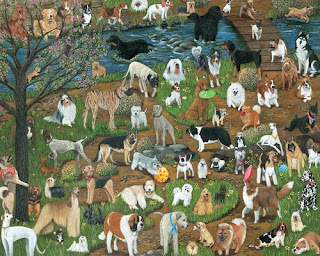
Hi Puzzlers,
Sports fans across the nation have begun to rejoice- it's spring training time! So today I would like to tell you about a fact from our country's national pastime that seems to be fading from memory, the All-American Girls Professional Baseball League.
During World War II major league baseball players were not drafted, but many of the young men who played on the minor leagues were. As a result most minor league teams disbanded. This disbandment left a huge gap in revenues generated by the Major League Baseball parks. Fear of collapse spurred Chicago Cub owner Philip K Wrigley to form a committee to search for possible solutions. The committee thus recommended using the girl’s softball league and so in 1943 the All-American Girls Professional Base-Ball League was born.
The first issue the committee needed to decide on was which game would be played. Women’s semi-pro softball teams at the time used a 12-inch softball and under handed pitching and teams consisted of ten players. In an effort to incorporate the two games the distance between bases were increased and men’s base running rules were incorporated; this allowed for the stealing of bases - and we all know how fun it is to watch for a stolen base! The team’s size was also reduced to 9 players.
Next, talent scouts scoured the country and Canada looking for players. Try-outs were held in all major cities and hundreds of women showed up looking for their chance to play for this new professional league. Sixty lucky women were chosen.
The women that were chosen had strict contracts forbidding any other type of employment during the season. Salaries ranged from $45 -$85 a week, which was higher than most of their professional parents. Strict moral codes of conduct would also have to be adhered to. Femininity was crucial. The girls received training on hygiene, etiquette, and dress codes. Charm school training also taught the girls how to act in every situation. “Physical attractiveness was a must and players received beauty kits and instructions on how to use them.” The All-American Girl Next Door, along with outstanding athletic ability was a top priority.”
The League's popularity peaked in 1948, selling 910,000 tickets to paying fans. By 1950, the league became decentralized and televised major league game saw to the demise of the All-American Girls Professional Baseball League, but not before giving over 600 women the chance to play baseball at a level never before obtained.
Happy Puzzling!
Sports fans across the nation have begun to rejoice- it's spring training time! So today I would like to tell you about a fact from our country's national pastime that seems to be fading from memory, the All-American Girls Professional Baseball League.
During World War II major league baseball players were not drafted, but many of the young men who played on the minor leagues were. As a result most minor league teams disbanded. This disbandment left a huge gap in revenues generated by the Major League Baseball parks. Fear of collapse spurred Chicago Cub owner Philip K Wrigley to form a committee to search for possible solutions. The committee thus recommended using the girl’s softball league and so in 1943 the All-American Girls Professional Base-Ball League was born.
The first issue the committee needed to decide on was which game would be played. Women’s semi-pro softball teams at the time used a 12-inch softball and under handed pitching and teams consisted of ten players. In an effort to incorporate the two games the distance between bases were increased and men’s base running rules were incorporated; this allowed for the stealing of bases - and we all know how fun it is to watch for a stolen base! The team’s size was also reduced to 9 players.
Next, talent scouts scoured the country and Canada looking for players. Try-outs were held in all major cities and hundreds of women showed up looking for their chance to play for this new professional league. Sixty lucky women were chosen.
The women that were chosen had strict contracts forbidding any other type of employment during the season. Salaries ranged from $45 -$85 a week, which was higher than most of their professional parents. Strict moral codes of conduct would also have to be adhered to. Femininity was crucial. The girls received training on hygiene, etiquette, and dress codes. Charm school training also taught the girls how to act in every situation. “Physical attractiveness was a must and players received beauty kits and instructions on how to use them.” The All-American Girl Next Door, along with outstanding athletic ability was a top priority.”
The League's popularity peaked in 1948, selling 910,000 tickets to paying fans. By 1950, the league became decentralized and televised major league game saw to the demise of the All-American Girls Professional Baseball League, but not before giving over 600 women the chance to play baseball at a level never before obtained.
Happy Puzzling!




